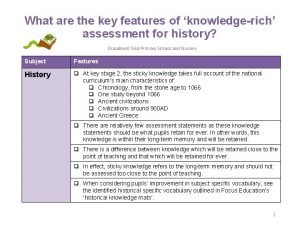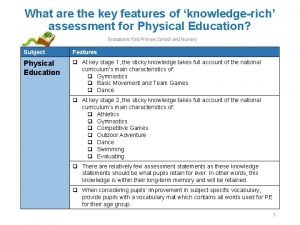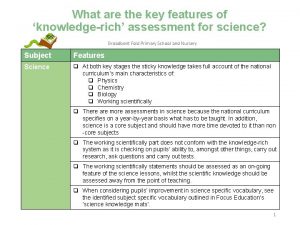What are the key features of knowledgerich assessment




- Slides: 4

What are the key features of ‘knowledge-rich’ assessment for Physical Education? Broadbent Fold Primary School and Nursery Subject Features Physical Education q At key stage 1, the sticky knowledge takes full account of the national curriculum’s main characteristics of: q Gymnastics q Basic Movement and Team Games q Dance q At key stage 2, the sticky knowledge takes full account of the national curriculum’s main characteristics of: q Athletics q Gymnastics q Competitive Games q Outdoor Adventure q Dance q Swimming q Evaluating q There are relatively few assessment statements as these knowledge statements should be what pupils retain for ever. In other words, this knowledge is within their long-term memory and will be retained. q When considering pupils’ improvement in subject specific vocabulary, provide pupils with a vocabulary mat which contains all words used for PE for their age group. 1

Physical Education: Key Stage 1 Gymnastic Movements Basic movements and Team Games Dance developing balance, agility and coordination, and begin to apply these in a range of activities master basic movements including running, jumping, throwing and catching, as well as participate in team games, developing simple tactics for attacking and defending perform dances using simple movement patterns • throw underarm • throw and kick in different ways Year 1 • make body curled, tense, stretched and relaxed • control body when travelling and balancing • copy sequences and repeat them • roll, curl, travel and balance in different ways • perform own dance moves • copy or make up a short dance • move safely in a space Year 2 • plan and perform a sequence of movements • improve sequence based on feedback • think of more than one way to create a sequence which follows some ‘rules’ • use hitting, kicking and/or rolling in a game • decide the best space to be in during a game • use a tactic in a game • follow rules • change rhythm, speed, level and direction in dance • make a sequence by linking sections together • use dance to show a mood or feeling 2

Physical Education: Key Stage 2 Athletics Competitive Games Gymnastics play competitive games, modified where appropriate [for example, badminton, basketball, cricket, football, hockey, netball, rounders and tennis], and apply basic principles suitable for attacking and defending develop flexibility, strength, technique, control and balance [for example, through athletics and gymnastics] Year 3 • run at fast, medium and slow speeds; changing speed and direction • take part in a relay, remembering when to run and what to do • be aware of space and use it to support team-mates and to cause problems for the opposition • know and use rules fairly • adapt sequences to suit different types of apparatus and criteria • explain how strength and suppleness affect performance Year 4 • sprint over a short distance and show stamina when running over a long distance • jump in different ways • throw in different ways and hit a target, when needed • throw and catch accurately with one hand • hit a ball accurately with control • vary tactics and adapt skills depending on what is happening in a game • move in a controlled way • include change of speed and direction in a sequence • work with a partner to create, repeat and improve a sequence with at least three phases • controlled when taking off and landing • throw with increasing accuracy • combine running and jumping • gain possession by working a team and pass in different ways • choose a specific tactic for defending and attacking • use a number of techniques to pass, dribble and shoot • make complex extended sequences • combine action, balance and shape • perform consistently to different audiences • demonstrate stamina and increase strength • agree and explain rules to others • work as a team and communicate a plan • lead others in a game situation when the need arises • combine own work with that of others • sequences to specific timings Year 5 use running, jumping, throwing and catching in isolation and in combination Year 6 3

Physical Education: Key Stage 2 Dance Year 3 Year 4 Year 5 Year 6 Outdoor and Adventurous Activity Evaluate perform dances using a range of movement patterns take part in outdoor and adventurous activity challenges both individually and within a team compare their performances with previous ones and demonstrate improvement to achieve their personal best • improvise freely and translate ideas from a stimulus into movement • share and create phrases with a partner and small group • remember and repeat dance perform phrases • follow a map in a familiar context • use clues to follow a route • follow a route safely • compare and contrast gymnastic sequences • recognise own improvement in ball games • take the lead when working with a partner or group • use dance to communicate an idea • follow a map in a (more demanding) familiar context • follow a route within a time limit • provide support and advice to others in gymnastics and dance • be prepared to listen to the ideas of others • compose own dances in a creative way • perform dance to an accompaniment • dance shows clarity, fluency, accuracy and consistency • follow a map into an unknown location • use clues and a compass to navigate a route • change route to overcome a problem • use new information to change route • pick up on something a partner does well and also on something that can be improved • know why own performance was better or not as good as their last • develop sequences in a specific style • choose own music and style • plan a route and a series of clues for someone else • plan with others, taking account of safety and danger • know which sports they are good at and find out how to improve further 4







